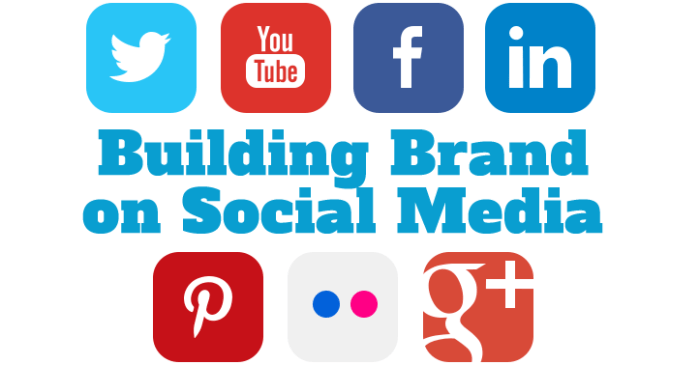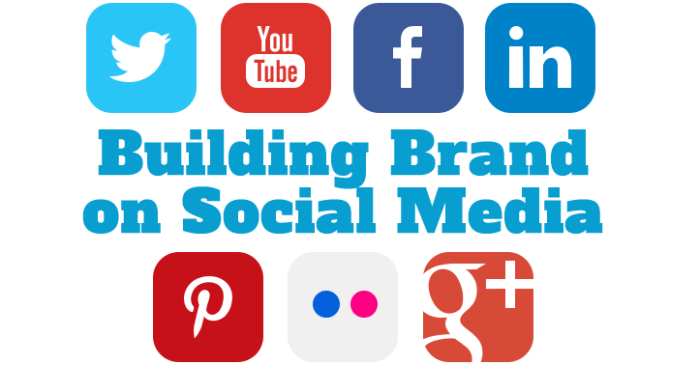Defining Your Brand Identity
How to build social media brand design – In the bustling world of social media, where countless brands compete for attention, a strong and distinct brand identity is crucial for success. It’s what sets you apart from the crowd and helps you resonate with your target audience. A well-defined brand identity acts as a compass, guiding your social media strategy and ensuring consistent messaging across all platforms.
It’s the foundation upon which you build your online presence and cultivate meaningful connections with your audience.
Examples of Successful Social Media Brands with Strong Identities
Several brands have successfully established themselves on social media through unique and memorable identities. Here are a few examples:
- Nike:Known for its empowering and motivational messaging, Nike’s social media presence is characterized by inspiring athletes and stories of overcoming challenges. Their use of powerful imagery and concise, impactful captions effectively conveys their brand values of determination and ambition.
- Red Bull:Red Bull’s social media strategy revolves around adventure, adrenaline, and pushing boundaries. They showcase extreme sports, daring stunts, and unique experiences, creating a sense of excitement and escapism for their audience. Their use of vibrant colors and dynamic visuals reinforces their brand’s association with energy and adventure.
- Airbnb:Airbnb’s social media presence is built around community, travel, and human connection. They share stories of travelers and hosts, highlighting the unique experiences and cultural exchanges that Airbnb facilitates. Their use of authentic imagery and personal narratives emphasizes the emotional aspects of travel and belonging.
Defining Your Brand’s Values, Personality, and Target Audience
Defining your brand’s values, personality, and target audience is the first step towards building a strong social media presence.
- Brand Values:These are the core principles that guide your brand’s actions and decisions. They represent what you stand for and how you want to be perceived by the world. Consider what is important to your brand and what you want to communicate to your audience.
For example, values like sustainability, inclusivity, or innovation can be central to your brand identity.
- Brand Personality:This refers to the human-like characteristics that define your brand’s tone of voice and communication style. It’s how you interact with your audience and the emotions you aim to evoke. Are you playful and humorous? Serious and professional?
Or maybe a mix of both? The key is to be authentic and consistent with your brand’s personality across all platforms.
- Target Audience:Identifying your target audience is essential for tailoring your content and messaging to resonate with them. Consider their demographics, interests, values, and online behavior. Understanding your audience allows you to create content that speaks directly to their needs and desires.
A Step-by-Step Guide to Defining Your Brand Identity
Here’s a step-by-step guide to help you define your brand identity:
- Conduct a SWOT Analysis:This involves analyzing your brand’s strengths, weaknesses, opportunities, and threats. This exercise helps you understand your brand’s current position and identify areas for improvement.
- Define Your Brand Values:Consider what is important to your brand and what you want to communicate to your audience.
Do not overlook explore the latest data about wikipedia influencing judicial decisions could manipulate judges mit.
Write down your core values and ensure they align with your brand’s mission and vision.
- Develop Your Brand Personality:Think about how you want your brand to be perceived. What are its key characteristics? What tone of voice will you use?
Create a brand persona that reflects your brand’s personality and values.
- Identify Your Target Audience:Who are you trying to reach with your social media content? Conduct thorough research to understand your audience’s demographics, interests, and online behavior.
- Create a Brand Style Guide:This document should Artikel your brand’s visual identity, including logo, colors, fonts, and imagery.
It should also define your brand’s voice and tone, ensuring consistency across all platforms.
“A strong brand identity is essential for success in the competitive world of social media. By defining your brand’s values, personality, and target audience, you can create a compelling and consistent online presence that resonates with your audience and drives engagement.”
Visual Brand Elements
Visual elements are the foundation of a strong social media brand. They’re what make your brand recognizable, memorable, and engaging. When done right, they create a cohesive and consistent look across all your social media platforms, leaving a lasting impression on your audience.
Logo
Your logo is the visual representation of your brand, acting as its signature. It’s the first thing people see, and it should instantly communicate your brand’s essence.
- Simplicity:A good logo is easy to understand and remember. Avoid cluttering it with too many details or elements.
- Relevance:The logo should reflect your brand’s values, personality, and offerings. For example, a tech company might use a modern and minimalist logo, while a fashion brand could opt for something more stylish and artistic.
- Versatility:Your logo should look good in different sizes and formats, whether it’s on a website, social media profile, or printed materials.
Color Palette
Colors play a crucial role in creating the right mood and emotions associated with your brand. They can evoke feelings of trust, excitement, or sophistication.
- Consistency:Choose a limited color palette and stick to it across all your social media platforms.
- Brand Association:Select colors that align with your brand’s personality and target audience. For instance, a brand focused on sustainability might use earthy tones like green and brown.
- Contrast:Ensure your colors have enough contrast to make your content easy to read and visually appealing.
Typography
Typography refers to the style of your fonts. Choosing the right fonts is essential for creating a consistent and professional look for your brand.
- Readability:Select fonts that are easy to read, especially on smaller screens.
- Brand Voice:The fonts you choose should reflect your brand’s tone and personality. For example, a playful brand might use a more whimsical font, while a serious brand could opt for a more formal font.
- Limited Choices:Stick to a maximum of two or three fonts to avoid overwhelming your audience.
Imagery
The images you use on your social media platforms are crucial for capturing attention and conveying your brand’s message. They should be high-quality, relevant, and visually appealing.
- Professional Photography:Invest in professional photography to ensure your images are top-notch.
- Visual Storytelling:Use images to tell stories, showcase your products or services, and connect with your audience on an emotional level.
- Consistency:Maintain a consistent visual style across your imagery, using similar colors, lighting, and composition.
Visual Style Guide
A visual style guide acts as a blueprint for your brand’s visual identity. It defines all the key elements, including your logo, color palette, typography, and imagery, ensuring consistency across all your social media platforms.
A well-structured visual style guide will help you maintain a consistent look and feel, making your brand more recognizable and memorable.
Content Strategy and Creation: How To Build Social Media Brand Design

Now that you’ve defined your brand identity and visual elements, it’s time to develop a content strategy that will bring your brand to life on social media. Content strategy is the backbone of your social media presence. It’s about creating a plan for what you’ll post, when you’ll post it, and how you’ll engage your audience.
Creating a Content Calendar
A content calendar is a crucial tool for organizing your social media posts. It helps you stay consistent with your posting schedule and ensures that you’re covering all the important topics that resonate with your target audience.
- Identify Your Target Audience:Before you start creating content, you need to understand who you’re trying to reach. What are their interests? What are their pain points? What kind of content do they consume?
- Define Your Content Pillars:Content pillars are the overarching themes that will guide your content creation. These could be related to your brand’s values, products, services, or industry expertise.
- Brainstorm Content Ideas:Once you have your content pillars defined, it’s time to start brainstorming specific content ideas. Think about different formats, like blog posts, infographics, videos, and social media posts.
- Schedule Your Posts:Use a scheduling tool like Hootsuite or Buffer to schedule your posts in advance. This will help you stay on top of your posting schedule and ensure that you’re consistently engaging your audience.
Content Formats
Social media offers a wide range of content formats that you can use to engage your audience.
- Text:Text-based content can be used for sharing updates, announcements, behind-the-scenes glimpses, and thought-provoking insights.
- Images:Images can be used to tell stories, showcase products, highlight events, and inspire your audience.
- Videos:Videos are highly engaging and can be used for tutorials, product demos, behind-the-scenes looks, and storytelling.
- Interactive Elements:Interactive elements like polls, quizzes, and Q&A sessions can encourage audience participation and build a sense of community.
Creating Engaging and Shareable Content
To create content that resonates with your audience and gets shared, consider these strategies:
- Tell Stories:People connect with stories. Use your content to share your brand’s story, customer stories, or stories that are relevant to your audience’s interests.
- Use Visuals:Visuals are more engaging than text alone. Use high-quality images, videos, and infographics to capture attention and make your content more memorable.
- Ask Questions:Encourage audience participation by asking questions in your posts. This can spark conversations and build a sense of community.
- Use Humor:Humor can be a great way to make your content more engaging and shareable. But be mindful of your brand’s voice and tone.
- Run Contests and Giveaways:Contests and giveaways can generate excitement and increase engagement.
- Collaborate with Influencers:Partnering with influencers can help you reach a wider audience and build credibility.
- Use Relevant Hashtags:Hashtags help people discover your content. Use relevant hashtags that are specific to your industry, target audience, and content topic.
Social Media Platform Selection
Now that you have a solid understanding of your brand identity, visual elements, and content strategy, it’s time to choose the right social media platforms to reach your target audience. Each platform has its own unique strengths and weaknesses, and selecting the right ones for your brand is crucial for success.
Platform Benefits and Drawbacks
Choosing the right social media platforms is a critical step in your brand’s online journey. Each platform has its own strengths and weaknesses, and selecting the best ones for your brand can significantly impact your success.
- Facebook: With a massive user base, Facebook offers broad reach and powerful advertising options. However, its organic reach has declined, making paid advertising essential for significant visibility.
- Instagram: Known for its visual appeal, Instagram is ideal for showcasing products, services, and lifestyle content. However, its algorithm prioritizes engagement, requiring consistent high-quality content to gain traction.
- Twitter: A platform for real-time conversations and news updates, Twitter is perfect for engaging with customers, sharing breaking news, and building brand awareness. However, its fast-paced nature requires frequent posting and a quick response time.
- LinkedIn: A professional networking platform, LinkedIn is ideal for B2B marketing, connecting with industry professionals, and building thought leadership. However, its focus on professional content may not be suitable for all brands.
- YouTube: A video-sharing platform, YouTube allows brands to create engaging content that can educate, entertain, and build trust. However, creating high-quality video content requires significant time and resources.
- TikTok: A short-form video platform, TikTok is known for its viral content and its ability to reach a younger audience. However, its rapid content cycle requires consistent creativity and adaptability.
Identifying Suitable Platforms for Your Target Audience and Content Strategy
To determine which platforms best suit your brand, consider your target audience and your content strategy.
- Target Audience: Identify where your ideal customers spend their time online. Are they on Facebook, Instagram, Twitter, or LinkedIn? Research their demographics, interests, and online behavior to gain insights into their platform preferences.
- Content Strategy: Align your content strategy with the strengths of each platform. For example, if your brand focuses on visual storytelling, Instagram and Pinterest might be ideal. If your brand emphasizes thought leadership and industry expertise, LinkedIn could be a better choice.
Tailoring Content for Different Platforms
Each social media platform has its own unique format and style. Tailoring your content to each platform is crucial for maximizing engagement and achieving your marketing goals.
- Visuals: Instagram and Pinterest prioritize visual content. Use high-quality images and videos that capture attention and convey your brand’s message.
- Text Length: Twitter’s character limit encourages concise and impactful messaging. Facebook and LinkedIn allow for longer posts, enabling more in-depth discussions.
- Frequency and Timing: Experiment with different posting schedules to determine the optimal times to engage your audience on each platform. Consider your target audience’s online activity patterns.
- Hashtags: Use relevant hashtags to increase discoverability and reach a wider audience. Research popular hashtags in your industry and tailor them to your specific content.
Building Community and Engagement
Building a strong community around your brand is crucial for long-term success on social media. It’s about fostering a sense of belonging and loyalty among your followers, turning them into advocates for your brand. A vibrant community can amplify your reach, increase engagement, and ultimately drive business growth.
Engaging with Followers
Engaging with your followers is key to building a thriving community. It’s about showing genuine interest in their thoughts, feedback, and questions. This goes beyond simply posting content; it involves actively listening and responding to comments, messages, and mentions.
- Respond promptly and thoughtfully: Aim to respond to comments and messages within a reasonable timeframe, showing that you value their input.
- Personalize your responses: Address followers by name and acknowledge their specific points. This shows that you’re paying attention and taking the time to connect with them.
- Ask questions and spark conversations: Encourage interaction by posing questions related to your posts or industry. This can generate discussion and deepen engagement.
- Acknowledge and appreciate feedback: Even if you don’t agree with every comment, show that you value their opinions and are open to feedback.
- Run contests and giveaways: This can be a fun way to engage followers, generate excitement, and boost brand awareness.
- Host Q&A sessions: This allows followers to directly ask questions and gain insights into your brand, products, or services.
- Collaborate with influencers: Partnering with relevant influencers can help you reach a wider audience and build credibility within your niche.
Community Engagement Strategies, How to build social media brand design
| Strategy | Impact |
|---|---|
| Live Q&A Sessions | Increases real-time engagement, fosters a sense of community, and allows for direct interaction with followers. |
| Contests and Giveaways | Generates excitement, drives traffic to your page, and encourages followers to share your content. |
| User-Generated Content (UGC) Campaigns | Encourages user participation, creates authentic content, and builds trust with followers. |
| Interactive Polls and Quizzes | Engages followers, gathers valuable insights, and makes your content more interactive. |
| Community Groups and Forums | Creates a dedicated space for followers to connect, share ideas, and support each other. |
Measuring and Analyzing Results
Building a successful social media brand isn’t just about creating great content and engaging with your audience. It’s also about understanding how your efforts are performing and using that data to improve your strategy. Measuring and analyzing your results is crucial for identifying what’s working, what’s not, and how to optimize your approach for maximum impact.
Key Metrics for Measuring Social Media Brand Success
The metrics you track will vary depending on your specific goals and objectives. However, some key metrics that are universally applicable include:
- Reach:The number of unique individuals who saw your content. This metric gives you an idea of how many people you’re potentially reaching with your social media efforts.
- Engagement:This refers to the level of interaction your content receives, including likes, comments, shares, and clicks. High engagement indicates that your content is resonating with your audience.
- Website Traffic:Tracking how many people are visiting your website from your social media channels can provide insights into the effectiveness of your content in driving traffic and generating leads.
- Conversion Rate:This metric measures how effectively your social media efforts are converting followers into customers or subscribers. It can be calculated by dividing the number of conversions by the number of visitors.
- Brand Mentions:Tracking mentions of your brand across social media platforms can give you an idea of how people are talking about you and whether your brand is generating positive or negative sentiment.
- Follower Growth:Monitoring the growth of your follower base over time can indicate the effectiveness of your social media strategy in attracting and retaining new followers.
Tracking and Analyzing Data
Several tools can help you track and analyze your social media data, including:
- Built-in Analytics:Most social media platforms offer their own built-in analytics dashboards, providing insights into your audience demographics, content performance, and engagement levels.
- Third-Party Tools:Several third-party tools, such as Google Analytics, Hootsuite Insights, and Sprout Social, offer more comprehensive analytics capabilities, allowing you to track data across multiple platforms and gain deeper insights into your audience behavior.
Using Data to Refine Your Social Media Strategy
Once you have a good understanding of your social media data, you can use it to refine your strategy in several ways:
- Identify Your Target Audience:Analyzing your audience demographics and interests can help you tailor your content to resonate with your ideal customer.
- Optimize Content Performance:By tracking the performance of different types of content, you can identify what’s working well and what needs improvement. This allows you to create more engaging and effective content in the future.
- Adjust Posting Schedule:Analyze your data to determine the optimal times to post content on different platforms. This ensures that your content is seen by the most engaged audience.
- Track Campaign Effectiveness:If you’re running social media campaigns, tracking their performance can help you measure their success and identify areas for improvement in future campaigns.





